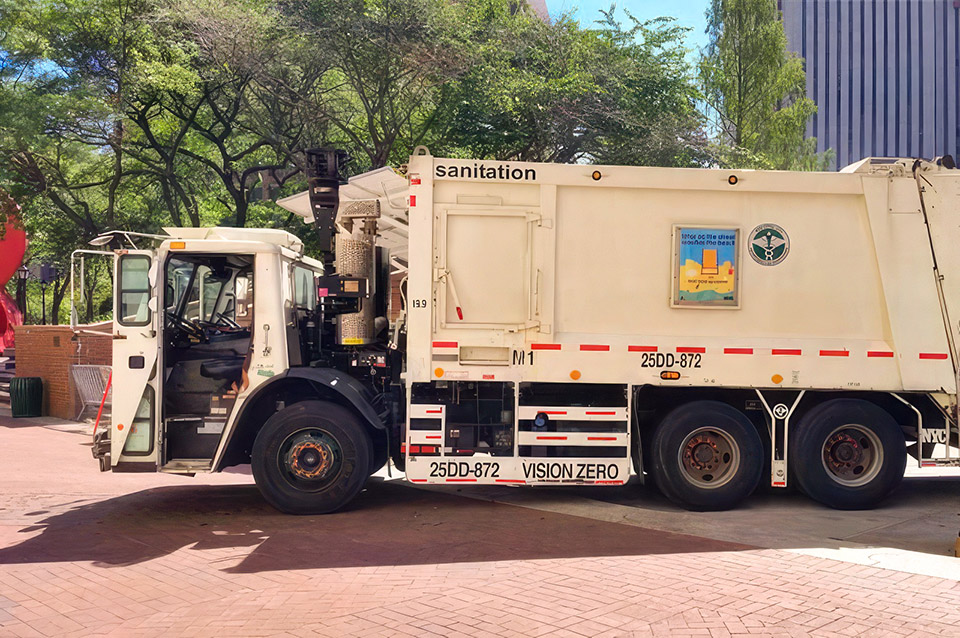
(Photo: NYC Department of Citywide Administrative Services)
In New York, biodiesel shines
December 14, 2023 | Bethany Baratta
A donation of B100 (100% biodiesel) to the city of New York spurred the city’s original use of biodiesel. That was nearly 20 years ago. Now, the Big Apple champions the use of biodiesel, made from soybean oil and other feedstocks, to heat homes and fuel city fleets.
A recent biofuels tour, hosted by Clean Fuels Alliance America (Clean Fuels), provided insights into the city’s growing adoption of biofuels to reduce carbon emissions.
Part of emission reduction strategy
NYC’s clean fleet plan commits to a 50% emission reduction by 2025. NYC Chief Fleet Officer Keith Kerman says the city is on track to meet this goal. Additionally, the city is working toward an 80% reduction in carbon emissions by 2035 for city fleet.
To accomplish these commitments, Kerman and city staff are working through three basic strategies:
- Electrify everything as soon as they can;
- Replace fossil diesel with biofuels; and
- Continue to implement hybrids and efficiencies.
“It’s going to take an all-of-the above approach to accomplish these goals,” says Kerman, deputy commissioner of the New York City Department of Citywide Administrative Services (DCAS). He spoke to a group of farmers and others joining in the Clean Fuels Alliance America NYC Biofuels Tour this week. He says the use of biodiesel, renewable diesel and electric vehicles concurrently is the most efficient and effective way to accomplish these carbon reduction goals.
New York City began using biodiesel in its fleet at NYC Parks Department in 2005. Parks and the city’s sanitation department used 5% to 20% blends of biodiesel through 2013 when Local Law 73 was passed, requiring biodiesel use for all non-emergency city trucks. All agencies, including the city’s police department, fire department and the department of corrections have been using biodiesel in their fleet for a decade. It’s also used in off-road equipment. In FY23, 93% of all diesel fuel used by fleet, on and off road, emergency and non-emergency, included biodiesel, according to Kerman.
An immediate solution
In the last 10 years, New York City government operations used more than 450 million gallons of fuel blended with biodiesel.
Electrification is the end goal, Kerman says, but using biodiesel is the cleaner fuel option available today.
“NYC will go to an all-electric fleet with a goal date of 2038,” Kerman says. “Zero emissions remain the best-case scenario for transforming fleet operations. However, as we work toward that transition, DCAS will be able to improve GHG and tailpipe emissions, especially for our heavy duty and emergency trucks, and off-road equipment, where viable electric options do not yet exist.”

Iowa Soybean Association District 9 Director Pat Swanson and New York City Chief Fleet Officer Keith Kerman discuss the city’s use of biodiesel during a biofuels tour in New York City on Dec. 13. (Photo: Bethany Baratta/Iowa Soybean Association)
Iowa Soybean Association District 9 Director Pat Swanson says the tour illuminated the role biodiesel plays in helping cities reach their emission reduction goals.
“For New York to embrace all the technologies—I really like that concept,” she says. “Why aren’t we all just as accepting?”
Home heating applications
BioHeat® Fuel, a blend of biodiesel and ultra-low-sulfur heating oil, has proven successful in New York State, one of the coldest regions in the U.S.
Biodiesel is required in blends of 20% in all heating oil, used in more than 1.4 million homes and buildings in New York State. This will increase to 50% by 2035.
A market research tour like the one in NYC helped demonstrate why cities are concerned about carbon emissions, Swanson says.
“I think we as farmers are a little more isolated. I think getting out here and talking to people who are looking at the big picture is helpful in understanding the challenges,” Swanson says. “They’re raising kids in the city—between two, four lane highways, next to subways, bus stations and near airports—all of which emit carbon. When you’re raising a family in the big city like this, how can you keep the air clean for your children? I think it’s good that they embrace more than one technology.”
Future opportunities
The NYC Biofuels Tour revealed another potential market for biodiesel: the marine market.
Worldwide, the annual marine fuel consumption is about 124 billion gallons. What could Iowa farmers stand to gain with additional fuel markets and demand?
“If you look at the growth we’ve made in production to meet the demand now and in the future, the market will dictate whether we grow soybeans for this market,” says Randy Miller, past Iowa Soybean Association president and farmer from Lacona. “It’s a chicken and the egg game—which comes first? I think the companies are betting on oil and us (farmers) to supply the demand based on the building of crush facilities. That will change our markets and dictate how much we grow.”
Back